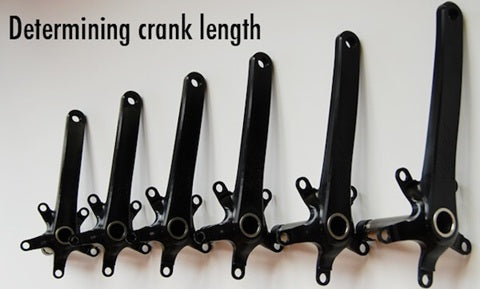
Best Crank Arm Length for Every Cycling Style | Boyer Cycling
The Ultimate Guide to Crank Arm Lengths: What’s Best for Your Ride?
Why Crank Arm Length Matters
Crank arms are the levers that connect your pedals to the bottom bracket. Their length determines your pedaling mechanics, power output, and overall comfort on the bike. Even small adjustments can make a world of difference in your performance and feel on the saddle. Bike crank arm lengths generally range from 165mm to 175mm, with 170mm and 172.5mm being the most common. Shorter cranks (165mm or even 155mm) are becoming more popular, particularly for shorter riders or those who prefer a higher cadence. Longer cranks (up to 180mm) are also available for taller riders. The ideal crank length depends on individual factors like height, leg length, and riding style.

Crank Arm Lengths by Discipline
Road Cycling
• Typical Lengths: 165mm–175mm
• Pros of Longer Cranks (170–175mm):
o Slightly more leverage for climbing
o Potential for higher power on flats
• Cons:
o Can increase knee stress on long rides
o Less efficient for riders with shorter inseams
• Best For: Taller riders, endurance cyclists, or those prioritizing power.
Mountain Biking (MTB)
• Typical Lengths: 165mm–175mm
• Pros of Shorter Cranks (165–170mm):
o Increased ground clearance on technical trails
o Quicker cadence for bursts of power
• Cons:
o Reduced leverage might affect climbing
• Best For: Riders tackling rocky or technical terrain, especially those with limited leg length.
Gravel & Adventure Riding
• Typical Lengths: 165mm–172.5mm
• Pros:
o Balanced compromise between power and cadence
o Smooth pedaling over varied terrain
• Cons:
o May need fine-tuning depending on frame geometry
• Best For: Versatile riders needing comfort and control across surfaces.
Indoor & Time Trial Bikes
• Typical Lengths: 145mm–170mm
• Pros of Shorter Cranks (145–165mm):
o Opens hip angle in aggressive aero positions
o Reduces knee stress during repetitive high-cadence sessions
• Cons:
o Requires adaptation period for muscle engagement
• Best For: Triathletes, indoor cyclists, or riders aiming for aerodynamic efficiency.

How to Choose the Right Crank Arm Length
While crank length is often influenced by tradition or manufacturer defaults, personalization is key. Here’s how to approach it:
• Measure Inseam: A general rule is 20% of your inseam = crank length in millimeters.
• Assess Riding Style & Goals: More technical terrain or faster cadence? Lean shorter. Need torque for climbs? Consider longer.
• Test and Tune: Many shops—including Boyer Cycling—offer bike fitting services or demo bikes with varied crank lengths.
• Consult the Experts: Reach out to BoyerCycling.com for personalized recommendations or a professional fit session.
Crank arm length isn’t one-size-fits-all. Getting it right means syncing your body mechanics with your riding style, and that’s where Boyer Cycling excels. We know that today's trend is smaller and smaller crank arms, that does not mean that is what is best for you or your style of riding. Whether you're building a custom setup or upgrading your ride, our team is here to help you dial in the details that matter.
